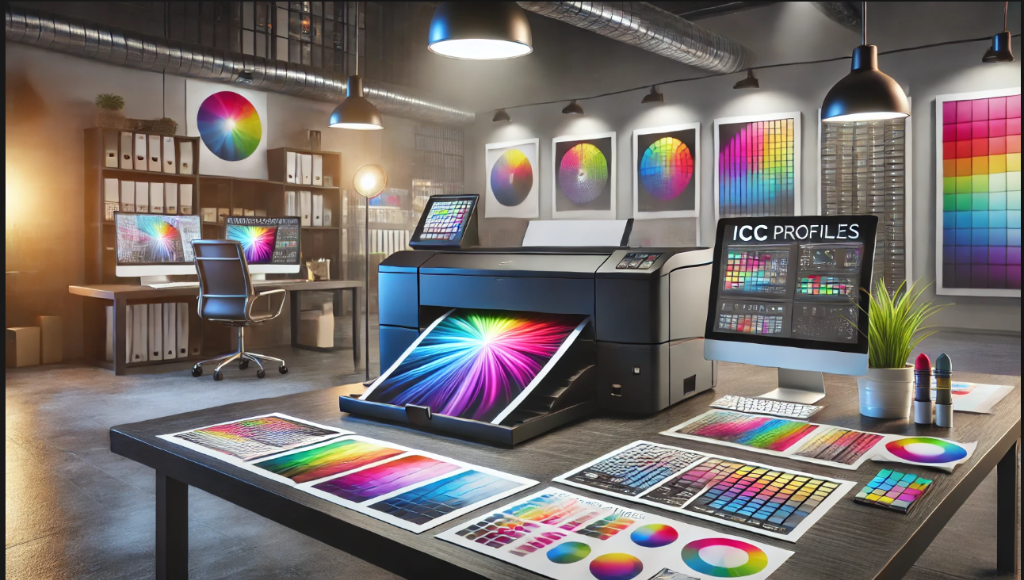
Digital printing, in general, is a key tool for both businesses and professional creators. However, achieving accurate and consistent color reproduction remains the greatest challenge. In this context, the so-called ICC Profiles (International Color Consortium) play a crucial role. In this article, we will analyze their importance, functionality, and how they contribute to the quality of the final printed result.
What is an ICC Profile?
An ICC Profile is a standard that defines how colors should appear across different devices, such as monitors, printers, scanners, etc. It was developed by the International Color Consortium, from which it gets its widely recognized name, to establish a unified approach to color management.
More specifically, each device has unique color reproduction characteristics, meaning that the same digital design may look slightly different on each device (e.g., an image viewed online will show color variations on different types of screens). However, when printing a design, color representation is no longer subjective and must correspond exactly to the expected result as seen on the screen. For example, imagine asking various print shops for a specific shade of red and receiving different results from each. An ICC Profile acts as a bridge, adapting color data to ensure consistent results across various devices.
The Importance of ICC Profiles in Digital Printing
- Color Accuracy
A properly configured ICC Profile ensures that the colors displayed on the screen closely match the printed output. This is particularly critical for professional applications, such as printing marketing materials, where accurate reproduction of a corporate logo is essential.
- Consistency in Quality
ICC Profiles minimize the likelihood of color deviations between successive prints or different printing machines. This ensures that each print meets the same quality standards.
- Time and Resource Savings
Printing without an ICC Profile often requires multiple trial-and-error attempts to achieve the desired colors, which costs both time and resources (materials). By applying appropriate and ideally customized ICC Profiles, the process becomes more predictable, while reducing waste.
- Process Flexibility
ICC Profiles enable easy transitions between different consumables (printing media, inks, or printers) without significantly affecting the quality of the final output. This flexibility is invaluable in high-demand production environments.
- Color Gamut Management
ICC Profiles allow full utilization of a device’s color range. For example, a printer with a broader color gamut can reproduce shades that other printers cannot. In other words, a well-constructed ICC Profile maximizes the printer’s capabilities.
- Interoperability
By using ICC Profiles, color data can be shared across different software and devices, ensuring consistency at every stage of production.
How ICC Profiles Are Created and Used
1.Creation
With specialized tools, typically spectrophotometers, the color output of a device is measured. Based on the collected data (digitally captured by the instrument), an ICC Profile file is created, reflecting the specific characteristics of the device.
2.Application
The ICC Profile file is integrated into color management software, known as RIP (Raster Image Processor), which is essential for any digital printer. This allows the color information of each file to be adjusted to the capabilities of the device.
3.Maintenance
It is crucial to regularly update ICC Profiles because printing machine performance changes over time, either due to wear and tear or changes in consumables.
4.Customization for Specialized Applications
In special cases, such as art or photography printing, customized ICC Profiles may be required to accurately reproduce complex colors and details.
Conclusion
Proper color management through ICC Profiles is a cornerstone of success in digital printing. Their use ensures accuracy, consistency, and efficiency while producing high-quality results. For businesses investing in printing, the adoption of customized ICC Profiles is not just an additional option but a strategic decision that enhances competitiveness, reliability, and trust with their clients.
If you would like to learn more about applying ICC Profiles to your printing activities, don’t hesitate to contact our team.





